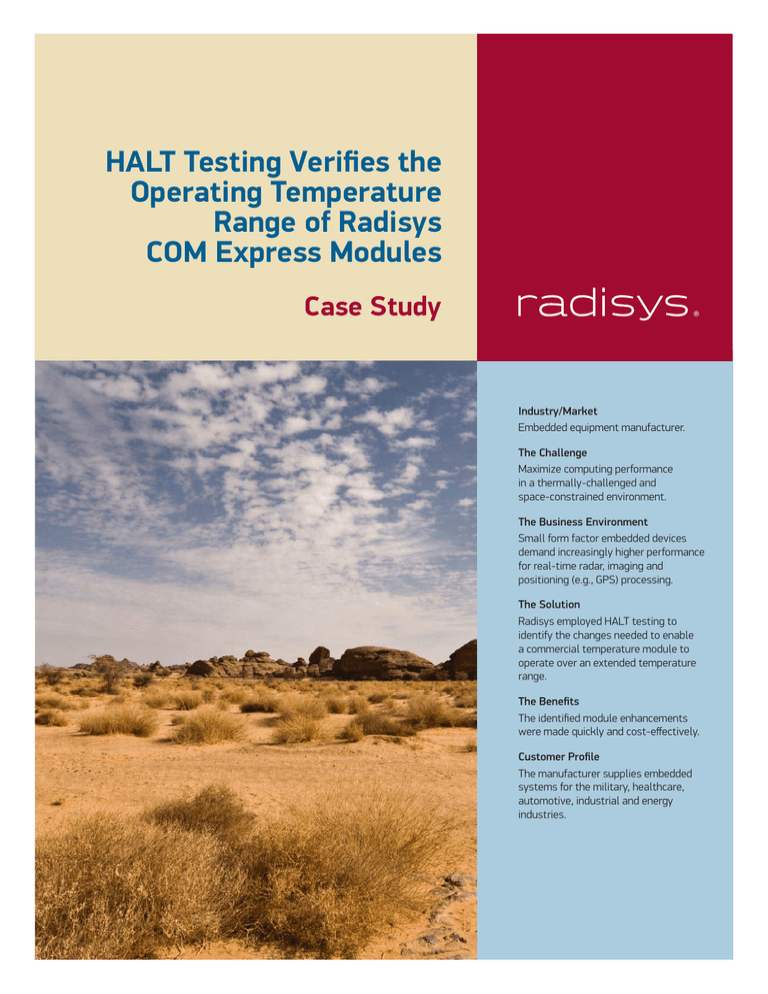HALT Testing Verifies the Operating Temperature Range of Radisys
advertisement

HALT Testing Verifies the Operating Temperature Range of Radisys COM Express Modules Case Study Industry/Market Embedded equipment manufacturer. The Challenge Maximize computing performance in a thermally-challenged and space-constrained environment. The Business Environment Small form factor embedded devices demand increasingly higher performance for real-time radar, imaging and positioning (e.g., GPS) processing. The Solution Radisys employed HALT testing to identify the changes needed to enable a commercial temperature module to operate over an extended temperature range. The Benefits The identified module enhancements were made quickly and cost-effectively. Customer Profile The manufacturer supplies embedded systems for the military, healthcare, automotive, industrial and energy industries. HALT Testing Verifies the Operating Temperature Range | Radisys Case Study The expansion of wireless networks is fueling the growth of mission-computing and high-performance embedded systems designed to handle the toughest environmental conditions, including extreme temperatures. Military, aerospace and energy are just a few of the industries that are pushing the envelope on performance, connectivity and robustness. Serving these market segments, an equipment manufacturer sought a small computing system capable of operating over an extended temperature range and based on an Intel processor. The company found the Radisys CEZ5XL COM Express module (commercial version) with a 1.6 GHz Intel® Atom™ processor delivered the desired performance; however, they also required extended temperature operation. In order to comply with the customer’s request, Radisys modified its commercial CEZ5XL module (0˚C to +60˚C) so it could achieve -25˚C to +75˚C operation. This was accomplished using HALT (Highly Accelerated Life Testing), which identified the components that needed to be replaced to satisfy the wider temperature range. At Radisys, we strive to offer our customers the right products and outstanding technical support, which can provide a competitive edge and faster time to market. Lorraine Orcino COM Express Product Line Manager at Radisys A Novel Way to Use HALT Testing The intention of HALT testing is to stress a product beyond its specification and until weak points fail, thereby determining the functional and destruct limits of the design. HALT testing exposes failure modes, which can be eliminated before a product is qualified. HALT testing typically subjects the product to extreme temperature and vibration conditions in a step-wise fashion. A thermal testing example is shown in the graphic on page 3, where the temperature is stepped as quickly as possible in 10 degree increments. Starting at ambient, the temperature is lowered for the cold test and raised for the hot test. The dwell time at each step is a minimum of ten minutes, and a full functional test is run on the product. As failure modes are discovered, they are corrected by modifying the design or substituting components until no further improvement is practical, or the fundamental limits of the underlying technologies are reached. Although the HALT process is typically employed during the design phase of a product, Radisys used it to enhance the CEZ5XL COM Express module and verify extended temperature operation. The process ensured the physical properties (e.g., solder joints and components) and electrical performance (e.g., signal set-up and hold times) of the board would easily withstand the wider temperature range. In this case, only a few module changes were required; thus HALT testing provided a fast and inexpensive alternative to designing an extended temperature board from the ground up. 2 HALT Testing Verifies the Operating Temperature Range | Radisys Case Study Designing A Carrier Board 90 80 70 60 Every 10 minutes, increase/decrease temperature by 10˚C, ramping as quickly as possible. Hot Step Test 50 Temperature (C) This project was the equipment manufacturer’s first foray into COM Express, and their engineers had to design a carrier board for use with a range of modules. Helping to jumpstart the design, Radisys engineers provided design rules, processor and thermal models, and schematic reviews. This technical support greatly reduced the company’s COM Express learning curve and decreased development time. 3 40 30 20 Ambient Temperature 10 0 -10 Cold Step Test -20 -30 -40 -50 Simplifying Board Management Time (Minutes) The HALT Process Employs a Step Stress The Radisys OEM Command Set API helped simplify the customer’s software migration to an Intel-based platform running Windows. The API allows the application software to control some embedded features in the operating system, such as tracking temperature events on the board. It used a standard protocol and hardware interface for monitoring and recovering features of the hardware environment. Benefits Of Choosing Radisys The embedded equipment manufacturer selected a COM Express module from Radisys because it satisfied performance and operating temperature requirements, and the technical support from the Radisys team lowered development risk. • Right Product: Radisys delivered an extended temperature module that met performance and environmental expectations. • Product Scalability: A family of modules supported multiple systems by scaling from Intel Atom processors to Intel® Core™ i7 processors. • Technical Support: Exceptional carrier board support improved time to market. • Software Support: The Radisys OEM Command Set APIs simplified software development. Corporate Headquarters 5435 NE Dawson Creek Drive Hillsboro, OR 97124 USA 503-615-1100 | Fax 503-615-1121 Toll-Free: 800-950-0044 www.radisys.com | info@radisys.com ©2011 Radisys Corporation. Radisys, Trillium, Continuous Computing and Convedia are registered trademarks of Radisys Corporation. *All other trademarks are the properties of their respective owners. December 2010



